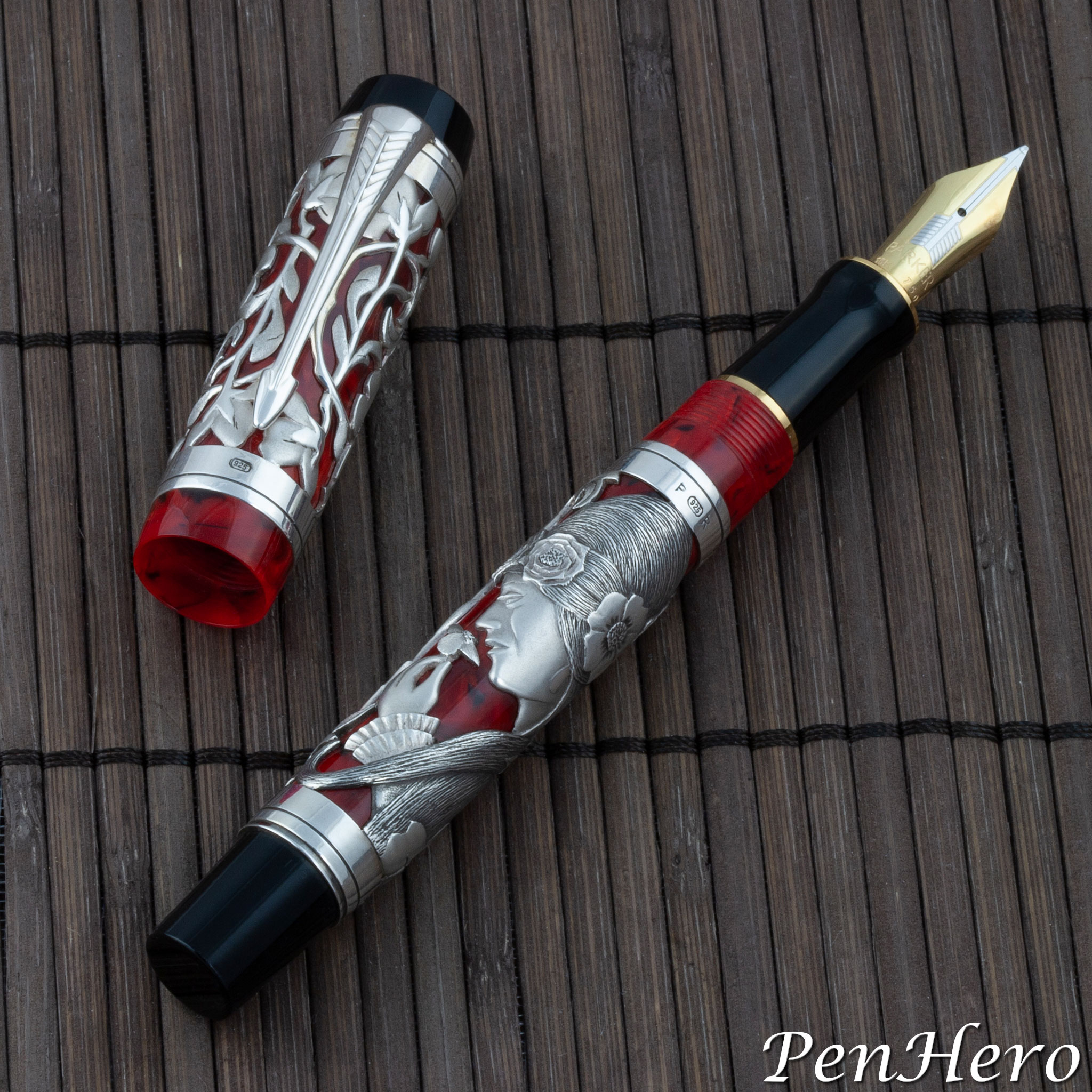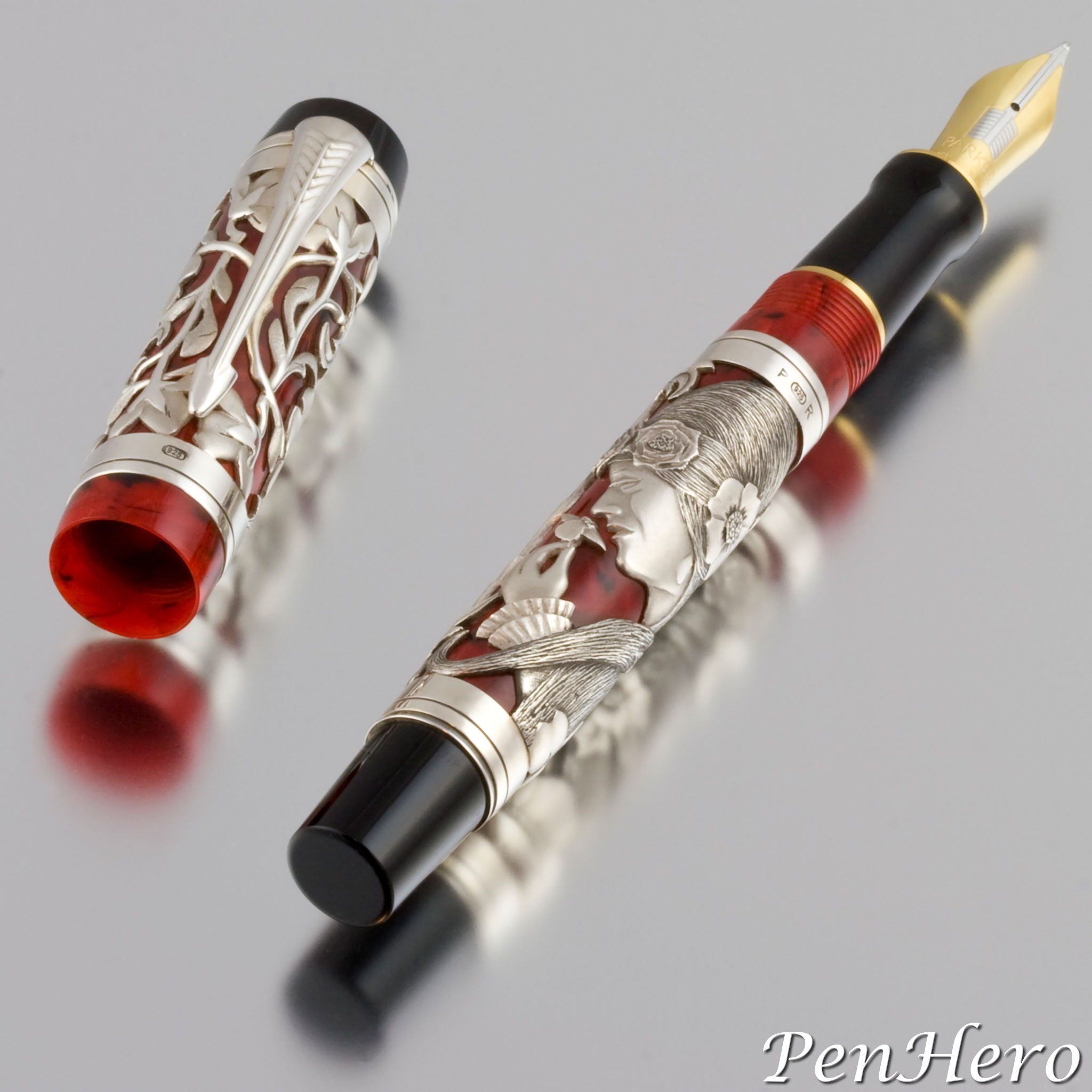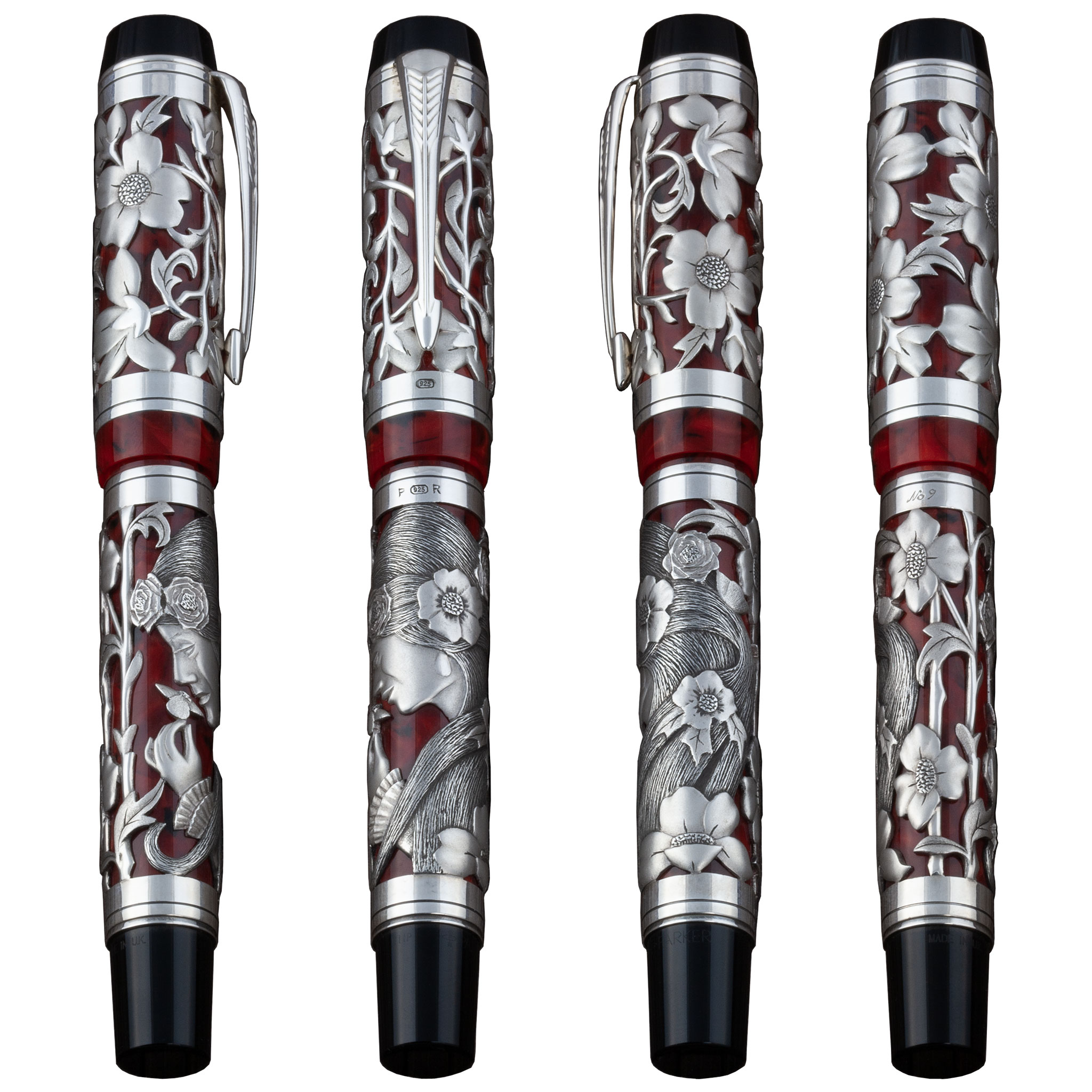Classic Pens LR4 Muse 2001
by Jim Mamoulides, February 16, 2024
 Classic Pens LR4 Muse fountain pen 2001
Classic Pens LR4 Muse fountain pen 2001
An Inspiration
The Classic Pens LR4 Muse fountain pen is the fourth pen in the LR series collaboration between Paul Rossi and Andreas Lambrou. Andreas Lambrou described the cut and carved sterling silver artwork by Paul Rossi as inspired by the “Muse of sculpture,” featuring on the barrel panel the Muse’s head in profile with her long flowing flower adorned hair. The cap panel features a lattice work of flowers with their stems and leaves. The overlays are on the Parker Duofold Centennial in Jasper Red, to highlight the artwork.
Greek mythology tells the story of nine Muses, daughters of Zeus, the king of the Greek gods, and Mnemosyne, the Titan goddess of memory. The various stories of the Muses tell of their role in the development of the arts and sciences of mankind, giving inspiration to artists, poets, musicians and scholars.
The nine Muses are, in birth order, according to several sources:
Calliope, or Kalliope, the Muse of epic poetry. Her name translates from Greek as “beautiful voiced.” She is often portrayed in art and sculpture holding a tablet or scroll and with a stylus, as if ready to write. Calliope was the eldest of the Muses and also known as the mother of Orpheus. Clio, or Kleio, the Muse of history and heroic deeds. Her name comes from the Greek word kleo, meaning “glory” or “famous.” She is often portrayed in art and sculpture holding a scroll or seated beside books. Melpomene, the Muse of tragic theater. Her name comes from the Greek word melpomai, meaning “celebrate with song.” She is portrayed in art and sculpture with a tragic mask and sometimes with the club of Heracles. Euterpe, the Muse of music, dance, and lyric poetry. Her name comes from the Greek words eu and terpô, meaning “giver of delight” or “pleasing.” She is portrayed in art and sculpture holding a double flute. Erato, the Muse of poetry, especially of love, including erotic love. Her name means “lovely” or “desired.” She is portrayed in art and sculpture holding a lyre, roses, or myrtle. Erato often has roses or other flowers in her hair, or is wearing them in a wreath. Terpsichore, the Muse of dance and choral song. Her name translates from the Greek words terpsis and khorosas as “delightful dancing.” She is portrayed in art and sculpture with a lyre. Urania, the Muse of astronomy. Her name translates from the Greek as “heavenly one.” She is portrayed in art and sculpture with a celestial globe. Thalia, the Muse of comedy. Her name comes from the Greek word thaleia, meaning “festive” or “blooming.” She is portrayed in art and sculpture with a comic mask. Polymnia, the Muse of sacred song, poetry, and dance. Her name comes from the Greek words poly (many) and hymn (praise). She is portrayed in art and sculpture in a meditative pose.
 Classic Pens LR4 Muse fountain pen 2001
Classic Pens LR4 Muse fountain pen 2001
Unfortunately, I never heard the complete story on how the Muse was chosen for this pen other than it was to be the “Muse of sculpture.” Considering the roses in the Muse’s hair and the flowers throughout both panels in the LR4’s artwork, it’s very possible that Erato is the Muse for the design on this pen.
Western artists and sculptors often referred to their female subjects as muses. Some of the most famous include Elizabeth Siddal, Georgia O’Keeffe, and Camille Claudel, who were artists in their own right, and Françoise Gilot, Muse to Pablo Picasso.
This pen continues the limited series Andreas Lambrou and Paul Rossi began developing in 2000 as the Classic Pens Lambrou Rossi LR collection. By the end that year, they decided on five designs. Each design is numbered, LR1 to LR5, and the collection debuted at the February, 2001 Los Angeles Pen Show.
 Classic Pens LR4 Muse fountain pen 2001
Classic Pens LR4 Muse fountain pen 2001
The design begins on the sterling silver filigree cut out barrel panel. The Muse’s head is in profile with her long flowing hair adorned with three roses, one five petal flower, and one four petal flower. She is surrounded by a lattice of vines with large flowers that extend up to the cap panel. She is leaning forward to enjoy the fragrance of one of the flowers.
The cap and barrel overlays are hallmarked 925 in an oval, indicating sterling silver, on the front near where the cap and barrel meet, and below the clip on the cap. The barrel overlay has Paul Rossi’s initials on either side of the hallmark. The back side of the barrel overlay is engraved with the edition number, as “No 9” for number nine.
The base pen for LR4 Muse is the Jasper Red Parker Duofold Centennial. The Duofold Centennial was introduced in 1987 as a modern interpretation of the flattop Parker Duofold of the 1920s. Parker updated the pen in 1996 with several new design changes, favoring the Duofold streamlined design introduced in 1929. The changes included a new two tone 18 karat gold nib, a tapered cap top, a new cap top emblem, a single plated band on the nib section, two wide cap bands, a single plated barrel end trim band, and a shorter barrel end cap. Interestingly, this pen has the nib from the earlier Duofold Centennial, but I don’t know the story behind why. In addition to black, three new marbled cap and barrel colors were introduced, Jasper Red, Jade Green, and Lapis Lazuli Blue, made from acrylic resin.
I don’t know how many LR4 pens were actually made, but I recall the edition was to be a total of ten. This example is number 9, so it’s likely that ten were made. These pens are highly prized, and a complete set is very valuable. They are rarely available for purchase.
References
Parker Duofold, by David Shepherd and Dan Zazove, 2006 Surrenden Pens Limited, Brighton, UK, pages 278, 316-319
MOUSAI, by Aaron J. Atsma, Theoi Project © Copyright 2000 - 2017
Interact
Comments on this article may be sent to the author, Jim Mamoulides


